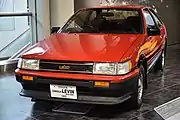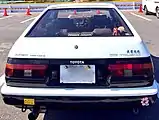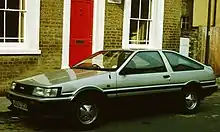Toyota AE86
The AE86 series of the Toyota Corolla Levin and Toyota Sprinter Trueno are small, front-engine/rear-wheel-drive models within the front-engine/front-wheel-drive fifth generation Corolla (E80) range—marketed by Toyota from 1983 to 1987 in coupé and liftback configurations.
| |
|---|---|
 1983–1985 Toyota Corolla Levin GT-APEX coupé | |
| Overview | |
| Manufacturer | Toyota |
| Production | May 1983[1]– Feb. 1987 |
| Model years | 1983–1987 |
| Assembly |
|
| Body and chassis | |
| Class | |
| Body style | |
| Layout | Front-engine, rear-wheel drive |
| Platform | E70[4][5] |
| Related | |
| Powertrain | |
| Engine | |
| Transmission | |
| Dimensions | |
| Wheelbase | 2,400 mm (94 in)[2] |
| Length | |
| Width | 1,625 mm (64 in)[2] |
| Height | 1,335 mm (53 in)[2] |
| Curb weight | 900–1,045 kg (1,984–2,304 lb)[7][11] |
| Chronology | |
| Predecessor | Toyota Corolla Levin/Sprinter Trueno TE71 |
| Successor | Toyota Corolla Levin/Sprinter Trueno AE92 |
Lending themselves to racing, the cars were light, affordable, easily modifiable and combined a five-speed manual transmission, optional limited slip differential, MacPherson strut front suspension, high revving (7800 rpm), twin-cam engine with oil cooler (e.g., in the US), near 50/50 front/rear weight balance, and importantly, a front-engine/rear-drive layout—at a time when this configuration was waning industry-wide.
Widely popular for Showroom Stock, Group A, and Group N, Rally and Club racing, the cars' inherent qualities also earned the AE86 an early and enduring international prominence in the motorsport discipline of drifting. The AE86 was featured centrally in the popular, long-running Japanese manga and anime series titled Initial D (1995–2013)—as the main character's drift and tofu delivery car. In 2015, Road & Track called the AE86 "a cult icon, inextricably interwoven with the earliest days of drifting."[12]
The AE86 would go on to inspire the Toyota 86 (2012–present),[13] a 2+2 sports car jointly developed by Toyota and Subaru, manufactured by Subaru—and marketed also as the Toyota GT86, Toyota FT86, Scion FR-S and Subaru BRZ.
In November 2021, Toyota temporarily restarted the production of a limited number of parts for the AE86, with dealers beginning to take orders for new steering knuckle arms and rear brake calipers. Rear axle half shafts have also been scheduled for new production. Toyota has also announced that this reboot is temporary, and parts will only be available as long as stocks last.[14][15]
Name

The nameplate Trueno derives from the Spanish word for thunder,[16] and Levin derives from the Middle English for lightning.[17] In Japan, the Sprinter Trueno was exclusive to Toyota Japan dealerships called Toyota Auto Store, while the Corolla Levin was exclusive to Toyota Corolla Store.
The name AE86 derives from Toyota's internal code during the car's development, designating the 1600 cc RWD model from the fifth generation of the Corolla. In Toyota's code language, the "A" designates the car's engine (4A series), "E" designates Corolla, "8" designates fifth generation (E80 series) and "6" designates the variant within this generation.
The AE86 is also called the "Hachi-Roku (ハチロク)", Japanese for "eight-six". Similarly the AE85 was commonly called "Hachi-Go (ハチゴー)", meaning "eight-five". Bracketing a minor external facelift, models marketed between 1983 and 1985 are called "zenki" (前期, lit. early period), and those marketed from 1986 to 1987 are called "kouki" (後期, lit. latter period).[18][19]
In 1986, Toyota marketed a limited edition model of the AE86 as the "Black Limited" model. It was advertised as a limited-production model with only 400 units, and was based on the Kouki Sprinter Trueno GT-APEX 3-door liftback.[20]
Engine/technical
The AE86 was available with a naturally aspirated 4A-GE 1,587 cc (1.6 L; 96.8 cu in) inline-four engine, a DOHC four-valve-per-cylinder motor, in Japan and Europe, which was also used in the first-generation MR2 G Limited (AW11), Corona GT (AT141), Celica 1600GT-R (AA63) and Carina 1600GTR (AA63) (Japan only) with a compression ratio of 9.4:1. It had a maximum SAE gross power output of 130 PS (128 hp; 96 kW) at 6,600 rpm and 110 lb⋅ft (149 N⋅m) at 5,200 rpm of torque in standard form,[21] though it was later down-rated to 120 PS (118 hp; 88 kW) and 105 lb⋅ft (142 N⋅m) in net output.[19] The 4A-GE engines used in the AE86 and AW11 were also equipped with Denso electronic port fuel injection and T-VIS variable intake geometry.
In North America, a modified 4A-GEC engine was used to comply with California emissions regulations. Power was rated at 112 hp (114 PS; 84 kW) and 100 lb⋅ft (136 N⋅m) of torque.[19]
The AE86 used ventilated disc brakes. The car was equipped with a MacPherson strut style independent suspension at the front and a four-link live axle with coil springs for the rear as well as stabilizer bars, front and rear, and an optional LSD.[19] The AE86 came with a 5-speed manual gearbox, and later came with the option of an automatic.
Higher-spec American AE86 models known as the Sport GT-S featured the DOHC 4A-GEC engine, four-wheel disc brakes, had a T-series 6.7" differential, color-matched bumpers, front lower bumper surround with a much more sporty and pronounced lip, molded door panels, tachometer redline at 7500 rpm, leather-wrapped steering wheel, seats with leather-wrapped tops (front seats are completely different from Sport SR5), optional LSD, and aluminium wheels. The VIN of the GT-S is AE88 (for North American market cars), however the chassis code on the engine firewall remained as AE86. The Sport GT-S can also be identified by the "Q" identification on the 4th digit of the model code, found on the chassis plate.
Lower-spec American AE86 SR5 models used the 1,587 cc (1.6 L) 4A-C SOHC unit, The S-series rear end was a 6.38" non-LSD with drum brakes. The SR5 model also had a softer suspension, and small styling and interior changes such as seats, gauge cluster, door panels, un-painted matte black front and rear bumpers, the lower part of the front bumper surround is shorter and flat, and its VIN differs as well, being AE86 for the SR5 model (for North American market cars). The SR5 can also be identified by the "X" identification on the 4th digit of the model code, found on the chassis plate.
Another lower-spec American AE86 model was the base-model DX, which had the same 1,587 cc (1.6 L) 4A-C SOHC unit and 6.38" non-LSD rear end with drum brakes as the SR5. It had a smaller center console, no rear sway bars, no air-conditioning, a very basic interior, and many options present on the GT-S and SR5 that were unavailable in the DX. The DX was an internal Toyota designation and was absent in advertising and brochures, as well as being more uncommon than the SR5 and GT-S. The VIN of the DX is AE85 (which is not to be confused with the Japan-only AE85), but as with the GT-S, the chassis code on the engine firewall remained as AE86. The DX can also be identified with the "D" identification on the 4th digit of the model code, found on the chassis plate.
Models equipped with the 4A-GE engine received a 6.7 in (170 mm) T-series rear differential, while 3A-U (only offered on the AE85), 4A-U and 4A-C models received a smaller, weaker, 6.38 in (162 mm) S-series rear differential.
The AE86 DX and SR5 (4A-C equipped) had an optional 4-speed automatic transmission alongside the 5-speed manual, however the GT-S model (with the 4A-GE DOHC engine) only came with a standard 5-speed manual gearbox.
One of the staff who was behind the car's engineering work was Nobuaki Katayama, who would later head the company's motorsport department and who would become chief engineer of the Altezza project a decade later. He has a photo of an AE86 hung in his office.[22]
Body styles

The Levin and Trueno featured fixed-headlights and retractable headlights respectively, with both available as hatchback or coupé. The export model name Corolla applies to both variations. The AE86 (along with the lower spec 1,452 cc (1.5 L; 88.6 cu in) AE85 and 1,587 cc (1.6 L; 96.8 cu in) SR5 and DX versions) was rear wheel drive, built on the rear wheel drive E70 Corolla platform[4][5] (same wheelbase length, interchangeable parts, etc.), unlike the front wheel drive E80 models in the same range.
Pre-facelift (Zenki)
 1983–1985 Corolla Levin GTV liftback (Japan)
1983–1985 Corolla Levin GTV liftback (Japan) 1984–1985 Corolla Levin GT Coupe with alternative optional grill (Japan)
1984–1985 Corolla Levin GT Coupe with alternative optional grill (Japan)_GT-Apex_2-Door_Coupe_in_Toyota_Automobile_Museum.jpg.webp) 1984–1985 Corolla Levin GT-APEX coupé with alternative optional grill (Japan)
1984–1985 Corolla Levin GT-APEX coupé with alternative optional grill (Japan) 1983–1985 Corolla Levin GT-V liftback (Japan)
1983–1985 Corolla Levin GT-V liftback (Japan)_rear.jpg.webp) 1983–1985 Corolla Levin GT coupé (Japan)
1983–1985 Corolla Levin GT coupé (Japan).jpg.webp) Initial D replica of 1983–1985 Sprinter Trueno GT liftback (Japan)
Initial D replica of 1983–1985 Sprinter Trueno GT liftback (Japan) 1983–1985 Sprinter Trueno GT-APEX liftback (Japan)
1983–1985 Sprinter Trueno GT-APEX liftback (Japan) 1984–1985 Sprinter Trueno AE85/86 coupé taillights (Japan)
1984–1985 Sprinter Trueno AE85/86 coupé taillights (Japan) 1983 Corolla 3-door liftback (AE86, UK)
1983 Corolla 3-door liftback (AE86, UK)
Facelift (Kouki)
Minor bodywork changes were made in May 1985, which resulted in different taillights, updated bumpers with wrap-around front indicators, corner and headlight trim lights, interior, and grilles. New paint colors have been shuffled around as well. Both the Levin and Trueno now have halogen lamps as standard. The seats on the GT-V and GT-APEX models have also been redesigned. They are the main differences for both AE85/86 Levin and Trueno coupé and liftback models.
.jpg.webp) 1985–1987 Toyota Corolla Levin GT-APEX liftback (Japan)
1985–1987 Toyota Corolla Levin GT-APEX liftback (Japan).jpg.webp) 1985–1987 Toyota Corolla Levin GT-APEX liftback (Japan)
1985–1987 Toyota Corolla Levin GT-APEX liftback (Japan) 1985–1987 Corolla Levin taillights on the 1985–1987 Corolla Sport SR5 coupé (US)
1985–1987 Corolla Levin taillights on the 1985–1987 Corolla Sport SR5 coupé (US)_with_VOLK_RACING.jpg.webp) 1985–1987 Sprinter Trueno GT-APEX coupé (Japan)
1985–1987 Sprinter Trueno GT-APEX coupé (Japan) 1985–1987 Sprinter Trueno coupé & liftback (Japan, with USDM bumpers)
1985–1987 Sprinter Trueno coupé & liftback (Japan, with USDM bumpers) A chart detailing the differences in taillight design of the AE86, showing the Zenki and Kouki versions of the taillights on the 2-door and 3-door versions of the Trueno/Levin.
A chart detailing the differences in taillight design of the AE86, showing the Zenki and Kouki versions of the taillights on the 2-door and 3-door versions of the Trueno/Levin.
Models/specifications
In Japan, the DOHC 4A-GEU AE86 was offered in GT, GT-V and GT-APEX trims as the Corolla Levin or Sprinter Trueno. In North America, the top-spec DOHC 4A-GEC was sold as the Corolla Sport GT-S[23] (with AE86 on the build plate in the engine bay but AE88 in the VIN), with the SOHC 4A-C being sold as the Corolla Sport DX and SR5[23] (with AE85 on the VIN but AE86 on the build plate in the engine bay in the DX and AE86 on the build plate and in the VIN in the SR5). Both versions were sold with Trueno pop-up headlights and Levin taillights, and had longer, heavier 5 mph (8 km/h) regulated bumpers in the front and rear. Euro-spec models were sold as the Corolla GT, Corolla GT Coupe, and Corolla GT-i, with DOHC engines and fixed Levin-style headlights. Australian models were sold as the Toyota Sprinter, also with fixed Levin headlights but with Trueno taillights.[6] New Zealand received a limited number of AE86s with DOHC 4A-GE engines, again with fixed Levin headlights. These AE86s were only offered in the 3-door liftback style. The Middle East received the same basic model as the North American market, with Trueno pop-up headlights, Levin taillights, and the regulated 5 mph (8 km/h) bumpers.
The lightest AE86 is the Japanese 2 door GT model which weighs about 900 kg (1,984 lb).[7] It has the same exterior as the GT-V trim, but with the interior of the AE85 with the exception of the gauges, and is equipped with rear drum brakes.
Japanese AE86 specifications
There are three types of the Corolla Levin and Sprinter Trueno for the Japanese market: GT, GT-V, and GT-APEX.
Note that all AE86 models produced in Japan featured the 1.6 L 4A-GEU engine.
Model codes (Sprinter Trueno)
- AE86-FCMQF: 4A-GEU, GT-V 5F/MT, 3-door liftback
- AE86-FCMVF: 4A-GEU, GT-APEX 5F/MT, 3-door liftback
- AE86-FCPVF: 4A-GEU, GT-APEX 4F/AT, 3-door liftback (Kouki only, Automatic, A44DE equipped)
- AE86-FSMQF: 4A-GEU, GT 5F/MT, 2-door coupe
- AE86-FSMVF: 4A-GEU, GT-APEX 5F/MT, 2-door coupe
- AE86-FSPQF: 4A-GEU, GT 4F/AT, 2-door coupe (Kouki only, Automatic, A44DE equipped)
- AE86-FSPVF: 4A-GEU, GT-APEX 4F/AT, 2-door coupe (Kouki only, Automatic, A44DE equipped)
Model codes (Corolla Levin)
- AE86-ECMQF: 4A-GEU, GT-V 5F/MT, 3-door liftback
- AE86-ECMVF: 4A-GEU, GT-APEX 5F/MT, 3-door liftback
- AE86-ECPVF: 4A-GEU, GT-APEX 4F/AT, 3-door liftback (Kouki only, Automatic, A44DE equipped)
- AE86-ESMQF: 4A-GEU, GT 5F/MT, 2-door coupe
- AE86-ESMVF: 4A-GEU, GT-APEX 5F/MT, 2-door coupe
- AE86-ESPQF: 4A-GEU, GT 4F/AT, 2-door coupe (Kouki only, Automatic, A44DE equipped)
- AE86-ESPVF: 4A-GEU, GT-APEX 4F/AT, 2-door coupe (Kouki only, Automatic, A44DE equipped)
Japanese model variations
GT-APEX
This trim level is the highest level of the AE86, offered in both 2-door and 3-door body styles and coming in both Levin and Trueno versions.
On the exterior, three two-tone paint colors are available, and had brown-tinted glass (a feature unique to the GT-APEX only, as all other models (including export models such as the SR5 and GT-S) had blue-tinted glass instead). It has power mirrors, adjustable interval windshield wipers, and a rear windshield wiper on liftback models. A special thermostatic flip-up grille was also available as an option on the Levin for the Zenki models. On the interior, they have the interior of the AE86 GT, with a three-spoke steering wheel, sport seats, power steering, a tilting steering column, rear defrost, air-conditioning, manual windows, and interior illumination dimming. A five-speed manual transmission is standard, with the option of a four-speed automatic transmission being offered on the Kouki models.
Options for this model include (but not limited to): limited slip differential (LSD), cruise control, power windows, power sunroof, digital instrument cluster, automatic air-conditioning, OEM aero sports package (available after Sep 1983), optional alloy wheels, Alpine sound system, fog lights on the Levin (Kouki models only), mudflaps, and rear hatch visor and quarter window billboards.
GT-V
This trim level is the upmarket lightweight-sports grade level of the AE86, coming in both Levin and Trueno versions. It was only offered in the 3-door body style. It features the interior of the AE86 GT, with a three-spoke steering wheel, smaller center console, sport seats, illumination dimming, and manual mirrors and windows. It had blue-tinted glass on the exterior, and had steel wheels with disk brakes on the front and rear. Side door decals denoting "GT-V Twin Cam 16" were added, exclusive to this model. A five-speed manual transmission is standard.
Options include (but not limited to): two-tone paint colors, air-conditioning, power steering, power mirrors, rear wipers, limited slip differential (LSD), optional alloy wheels, OEM aero sports package (available after Sep 1983), mudflaps and body-colored bumpers.
GT
This trim level is the lowest level of the AE86, serving as the base model of the AE86. They were mainly sold as vehicles aimed at competitive use. It was only offered in the 2-door body style and came in both Levin and Trueno versions. It used the interior of the AE85 SE, with a basic two-spoke steering wheel, smaller center console, basic seats, and manual mirrors and windows. It had blue-tinted glass on the exterior, and had steel wheels with basic disk brakes on the front and drum brakes on the rear. A five-speed manual transmission is standard, with the option of a four-speed automatic transmission being offered on the Kouki models.
Options include (but not limited to): air-conditioning, power steering, power mirrors, limited slip differential (LSD), optional alloy wheels, OEM aero sports package (available after Sep 1983), mudflaps, automatic transmission (Kouki models only), and rear defrost.
These models were the lightest out of any AE86 models, weighing in at about 900 kg (1,984 lb).
North American AE86 specifications
 1985 Corolla Sport GT-S liftback (US/Canada)
1985 Corolla Sport GT-S liftback (US/Canada).jpg.webp) 1985 Corolla Sport GT-S coupé (US/Canada)
1985 Corolla Sport GT-S coupé (US/Canada).jpg.webp) 1985 Corolla Sport GT-S coupé (US/Canada)
1985 Corolla Sport GT-S coupé (US/Canada) 1985-1987 Corolla Sport SR5 liftback (US)
1985-1987 Corolla Sport SR5 liftback (US) 1985–1987 Corolla Sport SR5 liftback (US)
1985–1987 Corolla Sport SR5 liftback (US)
There are three types of Corolla Sport RWD for the US market: DX, SR5, and GT-S. Although the DX was generally an internal Toyota designation, as brochures, and advertising do not include the DX designation;[19] it consisted of a lower trim level, lighter duty suspension parts and the like.
- Model Years of production: 1984 to 1987 (production started Sep 1983)
- Versions: DX, SR5 and GT-S (85+ Only)
- drag coefficient of Cd=0.39
Note that the VIN and the chassis code do not match for all models.
DX & SR5 specifications
- First 7 characters of VIN: JT2AE85 (DX) or JT2AE86 (SR5)
- Chassis code: AE86 (L) (which may differ from the VIN) (L designates LHD)
- Horsepower: 87 bhp (65 kW; 88 PS) @ 4800 rpm
- Torque: 115 N⋅m (85 lb⋅ft) @ 2800 rpm
- Weight: approximately 2,200 to 2,300 lb (998 to 1,043 kg)
- Engine: 4A-C, 1,587 cc (1.6 L; 96.8 cu in)
- Engine type: SOHC 8-valve Inline-4 carbureted
- M/T transmission: T50, 6-bolt flywheel
- A/T transmission: A42DL, 4-speed overdrive w/lockup torque converter, mechanically controlled, with electronically engaged overdrive
- Compression: 9.0:1 (varies; some early and late 4A-C engines have lower or higher compression ratios)
- Differential: 6.38 inches (162 mm) open with 4.10:1 ratio, 2-pinion (automatic) (S292) or 3.91:1 ratio, 4-pinion (5-speed) (S314)
- Wheels/tires: 13×5" +33 mm offset rims with 185/70R13 tires
GT-S specifications
- First 7 characters of VIN: JT2AE88
- Chassis code: AE86 (L) (which differs from the VIN) (L designates LHD)
- Horsepower: 112 bhp (84 kW; 114 PS) @ 6600 rpm
- Torque: 132 N⋅m (97 lb⋅ft) @ 4800 rpm
- Weight: approximately 2,200 to 2,300 lb (998 to 1,043 kg)
- Engine: 4A-GEC, 1,587 cc (1.6 L; 96.8 cu in)
- Engine type: DOHC 16-valve Inline-4 AFM Multiport Fuel Injection w/T-VIS
- Transmission: T50, 8-bolt flywheel
- Injector size: . 220 cc (13 cu in), low impedance
- Compression: 9.4:1
- Differential: 6.7 inches (170 mm) Open (T282) or optional LSD (T283) with 4.30:1 Ratio, 2-pinion
- Wheels/tires: 14×5.5" +27 mm offset rims with 185/60R14 82H tires (195/60R14 85H for 86+ models)
The AE86 in motorsports

While in production, the AE86 was a popular choice for showroom stock, Group A, and Group N racing, especially in rallying and circuit races. After production ended, many private teams continued to race the AE86, and it remains a popular choice for rallying and club races today.
Part of the continued appeal of the AE86 for motorsports is its rear-drive configuration, not available in most newer lightweight coupes. In Group A touring car races, the car either dominated the lower category where eligible or fought it out with Honda Civics or the later AE92s and AE101s whilst maintaining its competitiveness. In Ireland, where rallying is considered one of the most popular forms of motorsport, as organizing regulations are more relaxed compared to that of other countries, the AE86 was popular when new, and remains so popular that teams will purchase cars from the UK due to local shortages. The AE86 is also popular for rally use in Finland, where the cars can be competitive in the F-Cup competition for naturally aspirated 2WD cars.
The AE86 was entered in the European Touring Car Championship from 1984 to 1988 with a 150 hp (112 kW) 4A-GEU engine. In 1986 it beat the BMW M6, BMW 325i (E30), Rover Vitesse, Volvo 240 Turbo, Merkur XR4Ti, Mazda 929, Holden Commodore (VK), Alfa Romeo 75 (turbo V6), and Mercedes 190E 2.3-16 to win the Manufacturers Championship with 267 points, surpassing the 1986 Drivers Championship Schnitzer Motorsport BMW M6.[24]
In 1986 and 1987 Chris Hodgetts won the British Touring Car Championship (BTCC), beating the V8 Rover SD1's, Ford Sierra Cosworth's and BMW 3 Series (E30) M3's two years running for an overall points victory driving an AE86 for Toyota (GB) PLC and his own race prep team CHMS.[25]
The semi-factory supported Kraft team entered a spaceframe Trueno in the JGTC for the GT300 regulations in 1999. The Trueno used a Dallara F3 chassis and was powered with a 3S-GTE engine that came from a SW20 MR2 Turbo that produces about 300 hp (224 kW). Despite being popular with the fans, the car had minor success and was abandoned from use halfway through the 2001 season when the AE86 burst into flames during the third round of the season at Sugo. Kraft subsequently replaced it with the newly-delivered Toyota MR-S.[26][27]
The rear wheel drive configuration, combined with the AE86's light weight (approximately 2300 lb (950–970 kg) curb weight), balance and relatively powerful (and easy to tune) 4A-GEU engine made it popular among the Japanese hashiriya (street racers in Japanese), many of whom raced in touge (mountain passes in Japanese) where the corners suited the AE86 best, especially on the downhill.[19] Among those who utilized this car was Japanese racing legend Keiichi Tsuchiya also known as the Drift King ("Dori-Kin" in Japanese). Keiichi Tsuchiya helped popularize the sport of drifting, which involves taking a car on a set of controlled slides through corners.[19] The AE86's FR configuration made it well suited to this kind of cornering, and currently the car is a mainstay of drift shows and competitions. Japanese drifters like Katsuhiro Ueo, Toshiki Yoshioka, Yoichi Imamura, Koichi Yamashita, Hiroshi Takahashi, Tetsuya Hibino, and Wataru Hayashi were also involved in making the AE86 famous in the drift scene.
AE86s around the world have been extensively modified for use in professional drifting.[28]
In popular culture
_ver.INITIAL_D.jpg.webp)
The AE86 is considered as an iconic cultural symbol in Japanese popular culture following its inclusion in the Initial D anime and manga. The main character, Takumi Fujiwara, uses his father's AE86 Trueno GT-APEX liftback for racing and making his tofu deliveries. Takumi's friend, Itsuki Takeuchi, drives an AE85 Levin SR liftback. Throughout the series, two of Takumi's opponents drive AE86s: Wataru Akiyama, who drives a turbocharged (later supercharged) AE86 Levin GT-APEX liftback, and Shinji Inui, who drives the notchback coupé version of the GT-APEX AE86 Trueno. The AE86 is also a playable vehicle in the Initial D Arcade Stage series. The popularity of Initial D is cited as the main cause of the car's high resale price, which is often referred to as "Takumi tax" or "Tofu tax", after the main character and his tofu delivery occupation respectively.[29]
Production
The Toyota AE86 (as well as the AE85) was built in either the Kanto Higashi-Fuji plant, or the Takaoka plant. Over 360,000 AE86s are estimated to have been built in total.[30]
AE86s built at the (now-closed)[3] Kanto Higashi-Fuji plant came with a "5" designation at the beginning of the serial number. Their plant codes were "M21" and "M22". Only 28% of AE86s were produced at this plant, all of them being made for Japan with no export models being made.
AE86s built at the Takaoka plant came with a "0" designation at the beginning of the serial number. Their plant codes were "A54" and "A52". The majority of AE86s were produced at this plant (including exported AE86 models), as it was the original plant where the Toyota Corolla and Sprinter are manufactured.
References
- "Toyota Family Tree". toyota-global.com. Retrieved 2014-08-25.
- "75 years of Toyota - Sprinter Trueno 5th". www.toyota-global.com. Retrieved 2020-11-26.
- Hsu, Ben (2020-12-09). "The legendary Toyota plant that built the AE86, Mark II, and Century is now closed". Japanese Nostalgic Car. Retrieved 2021-11-14.
- Lye, Gerard (2020-11-26). "TAS 2020: Toyota 86 Black Limited Concept and AE86 Sprinter Trueno GT-Apex Black Limited on display". paultan.org. Malaysia. Retrieved 2020-01-17.
- Hsu, Dan (2011-06-08). "EVENTS: 2011 Toyotafest Part 06". Japanese Nostalgic Car. US. Retrieved 2020-11-26.
- "Australian Toyota Sprinter AE86 brochure 1983-10". Retrieved 2020-11-26.
- "Toyota Corolla Levin AE86 Japanese brochure". www.banpei.net. Retrieved 2020-11-26.
- "75 years of Toyota - Corolla Levin 5th". www.toyota-global.com. Retrieved 2020-11-26.
- "1986 Toyota Sprinter Trueno". japanclassic.ru. Retrieved 2020-11-26.
- Marcus, Frank (2018-05-17). "Feature Flashback: 1984 Toyota Corolla SR5". Motor Trend. Retrieved 2020-11-26.
- "US E80 Corolla catalogue". club4ag.com. Retrieved 2020-11-26.
- Sorokanich, Bob (2015-08-25). "Understanding the Allure of the Toyota AE86". Road & Track Magazine. Retrieved 2018-07-21.
- "Toyota Sports Car Heritage | Toyota 86 Predecessors". Arabia MSN Autos. Retrieved 2012-06-12.
- Gilboy, James (2021-11-01). "Toyota's Making New Parts for the AE86 Corolla Again". The Drive. US. Retrieved 2021-11-15.
- Pattni, Vijay (2021-11-02). "Toyota is building new parts for the old AE86 Corolla". Top Gear. UK. Retrieved 2021-11-15.
- "75 Years of TOYOTA | 5th Sprinter Trueno". Toyota. 2012. Retrieved 2020-06-25.
- "75 Years of TOYOTA | 5th Corolla Levin". Toyota. 2012. Retrieved 2020-06-25.
- Hachiroku.com.au Blog - はちろくブログ Archived 2012-02-11 at the Wayback Machine - AE86: An In-Depth Look at A Legend
- Drift Japan » Toyota Corolla AE86 Archived 2007-06-29 at the Wayback Machine - AE86 History and Overview
- "AE86 Trivia: all Sprinter Trueno AE86 Black Limited facts". Banpei.net. The Netherlands. 2013-12-14. Retrieved 2020-06-25.
- "Toyota Sprinter Trueno Coupé GT Apex, 1983 MY AE86 E-AE86-FSMVF specifications". carfolio. Retrieved 2018-06-15.
- "AE86". CAR Magazine. April 1999.
- MOOK, M.B. (2016-10-31). トヨタ・カローラ50年とその時代 [Toyota Corolla's 50 years] (in Japanese). Japan. ISBN 978-4866400150.
{{cite book}}: CS1 maint: location missing publisher (link) - "European Touring Car championship - 1986". Touringcarracing.net. Retrieved 2016-03-12.
- "BTCC Champions". British Touring Car Championship. Retrieved 2021-05-04.
- Alex Affat (6 January 2022). "The weirdest cars to race in Japan's JGTC/SuperGT championship". WhichCar. Retrieved 5 October 2022.
- "【忘れがたき銘車たち】懐かしい"ハチロク"が最新鋭マシンに⁉︎『JGTC AE86型スプリンタートレノ』" [[Unforgettable famous cars] Nostalgic "Hachiroku" turned into a state-of-the-art machine!? ︎ "JGTC AE86 Sprinter Trueno"]. auto sport Web (in Japanese). 17 May 2021. Retrieved 5 October 2022.
- Petrány, Máté (2014-11-21). "Europeans Have To Out-Crazy Japan When It Comes To Drift Cars". Jalopnik. Retrieved 2018-02-01.
- O'Mara, Sean (2013-01-28). "The Enduring Legacy of Initial D and the AE86". Retrieved 2013-02-01.
- Orlove, R. (12 February 2020). "Toyota Made 10x As Many AE86s As You Think". Jalopnik.
External links
 Media related to Toyota AE86 at Wikimedia Commons
Media related to Toyota AE86 at Wikimedia Commons